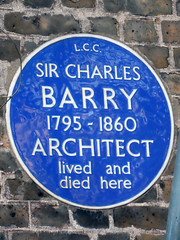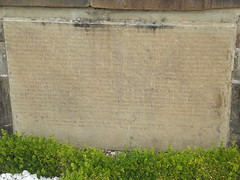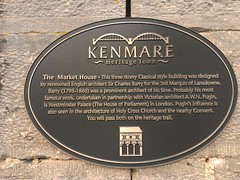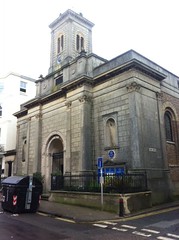Sir Charles Barry


Sir Charles Barry
(1795-1860)
architect and Knight Bachelor (from 1852)
Commemorated on 4 plaques
Sir Charles Barry 1795-1860 architect lived and died here
The Elms, 29 -32 Clapham Common North Side, SW4 0RN, London, United Kingdom where they lived and died (1860)
This memorial stone erected by Cromartie, Fourth Duke of Sutherland, A.D. 1913 marks the site of Trentham Hall, and of the following incidents connected with this place. In the Seventh Century Trentham formed part of the Demesne surrounding the residence at Bury Bank of Wulphure, King of Mercia. During the reign of Wulphure A.D. 659 - 674 one of the first Christian churches of Staffordshire was erected here by St Werburgh, the daughter of the King. St Werburgh also added a nunnery. At the conquest in A.D. 1066 King William I resumed possession of the Royal Demesne of Wulphure, and afterwards granted part of it as a manor to the Earls of Chester who before A.D. 1150 replaced the early church and nunnery of St Werburgh with a new church and a priory. At the reformation King Henry VIII again exercised his right to the ancient Royal Manor and although the priory was dissolved the church was preserved and it remained unaltered until re-built by George Granville 2nd Duke of Sutherland A.D. 1843 from a design by Sir Charles Barry, R.A. The original pillars of the nave of the Norman church were carefully preserved and restored on their ancient site. After the suppression of the priory A.D. 1538 the King sold the property in 1539 to the Duke of Suffolk and it was afterwards purchased by James Leveson in 1540. And the first Trentham Hall was either formed out of the old priory buildings or built on their site. An ancient plan dated 1599 shows it under the name of Manor of Trentham, and this was the residence occupied by Admiral Sir Richard Leveson for some years before his death in 1605. In A.D. 1634 a new hall in the Elizabethan style of architecture was erected on the site of the ancient priory by Sir Richard Leveson. K.B. In A.D 1690 the Elizabethan house was removed and the third Trentham Hall was built by Sir William Leveson Gower Baronet. This hall was much altered and enlarged by the first Marquis of Stafford, and the first Duke of Sutherland, until 1834, when it was re-constructed by the 2nd Duke of Sutherland in the Italian style from designs by Sir Charles Barry R.A. After the closing of Trentham Hall as a residence in 1905 it was offered for purposes of Higher Education. (1st) To the County Council of Staffordshire. (2nd) To the Mayor and Council of the Federated Borough of Stoke-on-Trent. But acceptance failing, the house was removed.
Upper Flower Garden - Trentham Gardens, Trentham, Stoke-on-Trent, United Kingdom where they designed (1833-1842)
The Market House - The three storey Classical style building was designed by renowned English architect Sir Charles Barry for the 3rd Marquis of Lansdowne. Barry (1795-1860) was a prominent architect of his time. Probably his most famous work, undertaken in partnership with the Victorian architect A.W.N. Pugin, is Westminster Pallace (The House of Parliament) in London. Pugin's influence is also seen in the architecture of the Holy Cross Churchand the nearby Convent. You will pass both on the heritage trail.
Market Street, Kenmare, Ireland where they designed
Sir Charles Barry 1795-1860 Architect of the Houses of Parliament, designed this church, consecrated in 1828
, Brighton, United Kingdom where they designed




